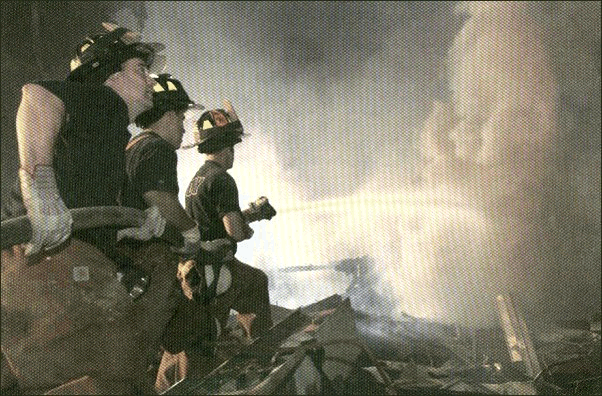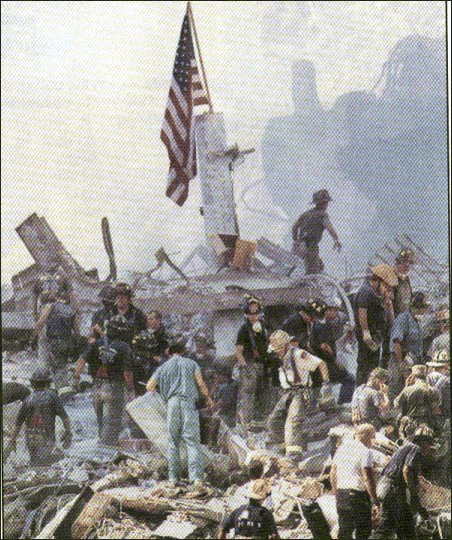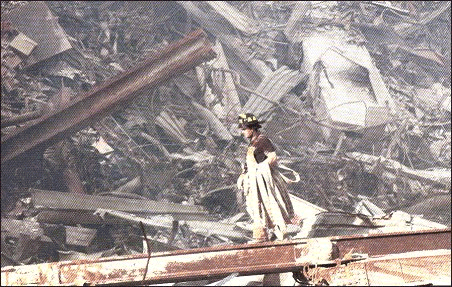|

FDNY Firefighter Mark
Bennett, left backs up his brother firefighters on "The
Pile".
The two towers were home to a hundred or more international
businesses, and served as pillars of the business world. The
buildings were modern marvels, wired with the latest electronic
technology, allowing tenants to conduct business instantly, with
clients around the world. Now, working through the rubble,
it seems odd to find no computers, no fax machines, no office
furniture, few indications that this was the workplace for tens of
thousands of business professionals.
Where Building
#4 once stood, steel beams have pancaked one atop the other,
compressing what had once been 10 foot tall room spaces into voids
barely large enough through which to pass my hand. The lower
we inspect the damage, the tighter these voids become.
Tonight the combination of smoke and lights creates strange
patterns in the sky as heavily backlit remnants of steel facade
cast bizarre shadows on surrounding high rises. The steady
hum of diesels is accented by the moaning of shifting steel.
It seems as if the debris actually speaks.
The
pile itself is unsystematic. At Church and Liberty the mountain
of debris stands some five stories. Then, as it moves east
toward the Hudson, it becomes a valley several stores deep.
Even through contractors have already carted away a week's worth
of debris, the bulk of the devastation remains. Progress is
slow, but the search and recovery effort continues in earnest.
There
are no strangers on the site. Everyone immediately talks to each
other as if they've known one another all of their lives. No
one complains -- except about the waiting -- and the New York locals are
extremely thankful.
"It's hard to believe, isn't it?" one firefighter
remarks, as he joins us at the edge of the pile. Using
phrases like "hard to believe" is the common greeting here
at Ground Zero, like saying hello. "heard any new
scoop?" he adds.
San Francisco Fire
Dept.
I pull up my goggles and quickly notice
that he's new to the pile - his work shirt crisp and clean.
Over his left breast the Maltese cross, the classic firefighter's
badge, frames a red number 4. His worn, black leather helmet
is familiar but it's accented in odd red and white hand painted triangles.
As he turns to address me, the frontpiece revels that he's from
Ladder-4, SAN FRANCISCO. He anticipates my question.
"We're not here officially" the seasoned truckie is
quick to report. "We're here to help out in any way
that we're needed!" He adds that a dozen other SFFD
members are working here at Ground Zero, even more are helping to
staff Manhattan fire stations.
3,000
miles from their first alarm district, 25 San Francisco
firefighters have joined thousands of other career and volunteer
firefighters, who are working this country's largest mutual aid
assignment. Even though San Franciscans have underwritten
this mission of mercy with cash donations, the volunteers from the
SFFD have opted to shoulder their own travel expenses, turning
over all contribution to New York's Uniformed Firefighters Association.
"It's peer support," says John Darmanin, who serves as
Director of San Francisco's Firefighter's Union, IAFF Local
798. "It is nearly impossible for FDNY members to seek emotional
support from their coworkers for fear of placing a further burden
on one another."
San
Francisco isn't the only distant fire department to answer the
call here in downtown Manhattan. There are responders here
from every major emergency agency.
Los Angeles Fire Dept.
Not long after the attacks, a team of
twenty six Los Angeles City firefighters arrived here in New York
in a mission organized by Paul Sebourn, a veteran LA City fire
captain who lives in San Juan Capistrano.
"We're here to pay back a debt to the FDNY members",
Sebourn tells press, referring to the cross country response of so
many New York firefighters during the King riots and Northridge
Earthquake. Leading that FDNY team was Ray Downey, the head
of FDNY's Special Operations Unit, who is still mission in this
hell.
Last night,
chaplains gather uptown at 54 Engine and 4 Truck, and we were surprised
to see yellow bunker gear hanging from the door of an FDNY
Seagrave. Even more unusual was the magnetic Los Angeles
CITY Fire Department logo, which was positioned neatly just below
the FDNY crest. Who could ever have imagined that six firefighters
from West Hollywood would become the first-in crew for New York's
famed Broadway district.
I'm
told that some 100 Los Angeles firefighters have taken vacation
and personal time, paying their own way to make the trip here to Manhattan.
Their actions are indicative of a brotherly calling in a profession
always on the run.
Chicago Fire Dept.
Within 72 hours of the collapse, about 50
Chicago area firefighters drove here to New York to help in the
recovery and cleanup. Like LA and San Francisco, the mutual
aid request is unofficial, but still welcomed by New York's
bravest.
"We've offered to sit in their firehouse, do anything for
them." says Roy Hervas, 42, a volunteer firefighter with the
Schaumburg (IL) Fire Department. "We came here to bring
them water and towels, whatever they need us to do."
Code3 -- Off Duty
On their way to New York, the group from
ChiTown was stopped doing 108 mph along the Indiana Turnpike.
To the trooper's surprise, ten vehicles pulled to the side of the
road, as the lead driver showed ID and explained the importance of
their mission. "Keep it at 90" the patrolman
instructed the driver, then he provided the convoy a speedy escort
to the Ohio state line. The Windy City contingent didn't
know it at the time, but when they'd finally arrived, they too
would be called onto the frontlines, pulling 12-hour shifts
sifting through the debris atop the pile.

"Little
America"
The unofficial Chicago Fire Department camp
is set up on Chambers Street, a few blocks from Ground Zero.
This ragtag team has dubbed their home away form home "Little
America", an out of the way place where they can nap on cots
of plastic tarpaulins, and in sleeping bags on the sidewalk.
Still the noise is deafening, as firefighters test power saws and
cranes creak in the rubble.
"We came here to help find our brothers." Hervas
adds. "And we're missing quite a few."
Collier County Fire
Dept.
Kelly West is a 30-year-old career
paramedic, who has traveled to Ground Zero from her hone in Collier
County, Florida. She's working on a bucket brigade with her firefighter
husband Jonathan, along with other friends from the Sunshine
State. She made the 22 hour trip to New York because she
considers FDNY a part of her family.
Even though they're newcomers to the pile, Kelly and her
colleagues know that they are welcomed here. "The (New
York) fire fighters can't say hi or anything with their masks
on," she says. "They just give you this look and
you know they appreciate the help."
A Special
Breed
Firefighters boast a tie that is stronger
than any church group or fraternal organization that I've ever
encountered. They live and die by this bond, and their
mutual respect for one another seems to have rubbed off on other
workers here at Ground Zero. ADD to my revised hero list the
ironworkers and other union trades, sanitation employees, mass
transit personnel and the reverend clergy.
The
Clergy
"I feel much more useful when I'm
working out on the pile." comes a new voice to our group of
visiting firefighters. The gentleman's black shirt and white
collar are oddly highlighted by worn blue jeans, goggles,
respirator and an NYPD hard hat. Not normal attire for a
Roman Catholic priest.
"Hi, I'm Father Ed Malloy." he says as his gloved
palm reaches out to greet each of us. "Sure hard to believe,
isn't it?" Hello to you too, father. Father Ed
tells us that he's been mixing with the crowds of emergency
workers here on the ramp of 10&10, meeting and greeting as
many workers as he can.
"What parish you from, padre?" I inquire, like I'm
familiar with every Diocese in the United States.
:"Notre Dame" he answers. "Ahh...I'm
president of Notre Dane University." The Indiana Jesuit
is here making the rounds, tending to the flock, just like hundreds
of other chaplains form dozens of faiths. I notice the
small, bookmarked Missal poking form Ed's back pocket.
"It takes fantastic moral strength to work here," he
says as he takes a long swig from the Gatorade bottle.
Father Ed believes that the determination of the rescue workers is
their most admirable strength.
The banter is interrupted by a squawk form the two way, and an
FDNY Battalion Chief motions for Father Ed to come onto the
pile. I tag along with the college president turned rescue
worker, staying close to his side like some self-appointed alter
boy. Engine 55's crew has just discovered the remains of a
woman, and have asked for a member of the clergy before she's
moved away to the morgue.
I stand quietly a few yards away, as Father Ed pulls the dusty
missal from his pocket to read a short prayer. Then turning
to 55's crew he prays, "May the blessing of God Almighty rest
and abide upon you and may this sign of the cross be your peace
and safety. In the name of the Father, Son and Holy
Spirit."
I join him in the sign of the cross, clasp my hands to the front
and bow my head. Normally, we would have already removed our
helmets in respect for the deceased, but the Battalion reminds us,
"Keep your lids gents, OSHA may be watching!"
The Red
Cart
From the corner of my eye, I watch as
second crew uncovers the remains of another victim. From
where I'm standing it appears that they've discovered a large part
- perhaps a torso. Ever so gently, the firefighters situate
it in the black body bag and lift it to a waiting stokes
basket. Led by the Battalion Chief, six helmeted FDNY
members slowly carry the stretcher to the hard surfaced roadway.
Like so many others who have been found, this person passed will
make the final trip aboard a red 4x4 cart and transported to one
of the temporary morgues. God, do we hate seeing that red
cart.
Even though the FDNY has suffered such an incredible loss, their
strength as a cohesive, working team remains rock solid.
there is no question as to who's running this show. It is
undoubtedly the FDNY.
Discipline pays off in this strange world. There is no time
for individuals to bicker about who is in charge; no time to
complain or criticize. Fire-rescue's para-military command structure
functions best during crisis like these. Things get done,
even if it isn't always the most efficient way.
I leave Father Ed to his spiritual duties and come off the pile to
rejoin the group I pause by the command post in front of Ten
House, hoping that some of FDNY's experience will rub off on
me. The scene is directly form "Saving Private
Ryan". Battalion commanders calmly give instructions to
company level officers, who then move out into the swarm of
firefighters to pass along orders to their own crews. Aides
are busy on cell phones and two way radios coordinating with other
sector commanders. Everyone seems to consult the huge map
table, with its layers of acetate overlays.
A Family
Tradition
Here in New York, firefighting is often
regarded as a family tradition - a calling that is handed down
from one generation to the next. Many firefighting families
can trace their roots to the beginning of the "paid"
department in the late 1800's.
I listen as one father and son team trade jibes - the discussion
being who's in and who's out. The younger firefighters jokes
with the old man, "You're already retired Dad, you work on a
Truck Company." Everyone who hears the answer laughs
openly. It's the first laughter I've heard in days.
I ask a lone firefighter if anyone in his company is lost.
"We've lucked out', he responds, "but my brother, a cop,
is still missing." His eyes water as he answers, and
all I can manage to do is touch his shoulder like I understand.
Many New York firefighters that I've spoken to feel that they're
alive because of fate. Some say that they were late for work
on the 11th, or their truck got caught in traffic. Others were
on vacation, or it was their day off. So even after they've
worked their shift in the "pit", they refuse to leave.
Instead of taking a well-deserved rest, most simply stay behind,
standing here at the edge of Hell, waiting for their buddies to be
brought home. Even though their bodies and souls are tired,
that's what they do -- watch and wait. |